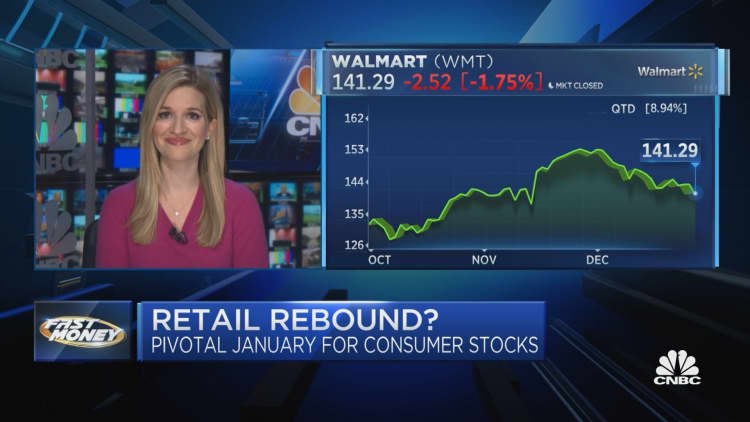A consumer goes by shirts within the children part at Old Navy in Denver, Colorado.
Brent Lewis | Denver Post | Getty Images
January is often an ignored month for retailers.
Shoppers make returns and exchanges. They come to shops with reward playing cards in hand. And they could spring for exercise garments or different gadgets to comply with by on New Year’s resolutions.
But this 12 months, January carries greater stakes. The subsequent few weeks, which shut out many retailers’ fiscal 12 months, may assist decide whether or not the vacation quarter is a win or a bust. It’s an vital time for serving to shops filter extra stock, too. January may additionally set the tone for 2023 — when some economists and retail trade watchers anticipate the U.S. will tip right into a recession.
So far, early vacation outcomes have been higher than some economists and retailers feared. Sales from Nov. 1 to Dec. 24 rose 7.6%, in accordance with knowledge from MasterCard SpendingPulse, which measures in-store and on-line retail gross sales throughout all types of cost. The determine consists of eating places and isn’t adjusted for inflation, which rose 7.1% 12 months over 12 months in November.
Yet there are indicators that buyers could also be operating out of gasoline. Credit card balances have ticked up. Personal saving charges have fallen. And gross sales of big-ticket gadgets like jewellery and electronics have weakened.
Plus, Americans’ spending spree through the earlier years of the pandemic, fueled by stimulus cash, boredom and socked-away financial savings, have made for powerful comparisons.
A pivotal January
Retailers enter 2023 reckoning with the truth that retailer visitors already lagged throughout peak weeks of the vacation season.
Across six retailers — Walmart, Target, Best Buy, Nordstrom, Kohl’s and Macy’s — foot visitors dropped by a median of three.22% 12 months over 12 months for the weeks from Black Friday by the week of Christmas, in accordance with knowledge from Placer.ai, an analytics agency that makes use of anonymized knowledge from cell units to estimate total visits to places. It additionally declined by almost 5% when in comparison with pre-pandemic patterns.
Now retailers are extra on edge.
“It seems like a lot of the brands are anticipating a bigger thud in January,” stated Stacey Widlitz, president of SW Retail Advisors, a consulting agency.
She has seen extra retailers are dangling reward playing cards to drum up gross sales. For occasion, Urban Outfitters-owned retail chain Anthropologie on Friday supplied $50 towards a future buy for web shoppers who spend $200 or extra. But that bonus money have to be utilized by Jan. 31, when the corporate’s quarter ends.
Widlitz stated these presents are targeted on nudging buyers to make purchases throughout a time when there’s usually a post-holiday lull. It can also be retailers’ final likelihood to promote by extra stock and begin the brand new fiscal 12 months in a cleaner place.
“It just looks like they’re trying to push people to get into stores after the new year,” she stated.
But for some, a extra budget-sensitive shopper may very well be a possibility.
On an earnings name final month, Walmart CEO Doug McMillon stated he anticipates a lift in gross sales as shoppers really feel stretched from vacation spending. Like many different retailers, Walmart’s vacation quarter consists of January.
“Sometimes these quarters work out where the very end of December and January end up being stronger when people are particularly price sensitive,” he stated. “So that’s kind of what I’m expecting.”
Already, the discounter has attracted wealthier buyers with its lower-priced groceries and family staples. For the previous two quarters, about 75% of its market share positive factors in meals got here from households that make greater than $100,000 a 12 months.
Yet like opponents Target and Costco, it has had a more durable time promoting discretionary merchandise that tends to drive greater earnings than promoting milk or paper towels.
What will the brand new 12 months deliver?
Economists are carefully watching shopper indicators because the 12 months begins.
On the optimistic facet, stated Michael Zdinak, an economist at S&P Global Market Intelligence, unemployment is low and the roles market remains to be very tight. There are indicators that inflation has cooled, with costs rising lower than anticipated in November, the newest month of accessible federal knowledge.
On the opposite hand, he stated meals costs are nonetheless excessive, retail demand is weakening and financial savings aren’t trying as strong.
Personal saving charges have declined considerably. The proportion of disposable earnings that individuals save was 2.4% in November, in accordance with the U.S. Bureau of Economic Analysis. That’s down from a median of 6.3% pre-pandemic, in accordance with S&P Global Market Intelligence, which crunched the numbers from 1991 to 2019.
Zdinak stated that low price is unsustainable, particularly as shoppers have been spending cash they put of their financial savings accounts through the earlier months and years of the pandemic.
Economists on the market knowledge agency anticipate a recession to start within the first quarter of 2023 and to final two quarters.
Zdinak stated the downturn might be fueled by slashed orders and fewer manufacturing as many retailers clear by undesirable stock after shopper preferences modified abruptly in 2022.
Then there are headwinds for shoppers. Reality might quickly hit households who’ve blown the finances on items or vacation journey, stated Widlitz of SW Retail Advisors.
“Everyone gets through the holidays in denial and Feb. 1, when you get your [credit card] statement, or Jan. 15, whenever it comes, it’s like, ‘Oh!'” she stated.
— Caitlyn Freda contributed to this report.


